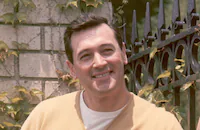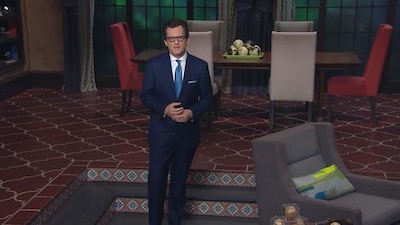Here Come the Nelsons

Brief Synopsis
Cast & Crew
Frederick De Cordova
Ozzie Nelson
Harriet Nelson
David Nelson
Ricky Nelson
Rock Hudson
Film Details
Technical Specs

Synopsis
One morning in the town of Hillsdale, Ozzie and Harriet Nelson share breakfast with their young sons, David and Ricky. When neighbor Clara Randolph arrives with hordes of overexcited neighborhood children, waiting to attend the town's Centennial Pageant, Ozzie escapes to the relative calm of his advertising office. His boss, H. J. Bellows, who is waiting for him, announces that they have landed the account for Samuel Jones, a millionaire businessman launching a new line of ladies' girdles. With only a few days to come up with a sensational, splashy idea, Ozzie settles in to work. Later that day, he bumps into Barbara Schutzendorf, an old buddy's younger sister who has grown into a beautiful woman, and is in town to perform in the Centennial rodeo. While Ozzie invites her to stay at his house, they are watched by handsome Charlie Jones, who then tries to find out Ozzie's name. Meanwhile, at the fairgrounds, Harriet and Clara visit astrologer Clifford Hastings, who predicts that Ozzie will experience upheaval in the next few days and be attracted to younger women, and exhorts Harriet to remain understanding. Later, Ozzie's old pal Al Brown calls, and Harriet, not knowing about Barbara, invites him to stay in their guest room. On Ozzie's way home from work, he stops to talk to Clara's husband Joe, who assumes that Harriet will be furiously jealous of Barbara. Ozzie then returns home to find Harriet making up the guest bedroom for Al, and cannot bring himself to explain about Barbara. After Harriet leaves for the grocer's, Barbara arrives, and although she is standing suspiciously close to Ozzie when Harriet returns, Harriet recalls Clifford's words and says nothing. Ozzie proudly relates this to Joe the next morning, but is concerned at Joe's inference that only a wife with something to hide would not be jealous. Later, Ozzie tries to impress Harriet by buying new clothes, but she ignores them, assuming they are for Barbara's benefit. That night, Charlie shows up at the door, lying that Al Brown told him to come in his place. He is really there to see Barbara, who has recently broken up with him, and although she puts on her best dress after hearing his voice, she then pretends not to know him. At dinner, Charlie regales David and Ricky with rugged football-hero stories and flirts with Harriet, causing a jealous Barbara to turn her affections to Ozzie. While the adults dance, the boys try to unpack Charlie's padlocked bags and are thrilled to find one with an FBI identification. The next day, hoping to prove his masculinity to Harriet, Ozzie signs up for a rodeo contest in which he will have to ride a wild horse named Dynamite. On the other side of the fairgrounds, the boys eavesdrop as Charlie informs Barbara that he finally has a good job with Uncle Sam and will soon be able to ask her to marry him. Later, Jones arrives in town and is angered to discover that Ozzie has no ad ideas ready for him. Just after Ozzie calls Harriet to tell her that he must work through the night, Barbara calls with the same news, and Harriet imagines that they are spending the night together. The rodeo takes place the next morning, and after Ozzie's name is announced for the contest, Harriet runs to stop him, but turns away after an old-time rodeo star conjectures that Ozzie must be trying to impress a woman. The horse quickly throws Ozzie, who, humiliated, also realizes that he has only one hour to think up a publicity stunt for Jones. Just then, Ricky and David stumble upon two con men robbing the fair office, and while David runs to inform Ozzie and grab Charlie's bags, which he assumes are full of weapons, Ricky hides in the back of the office to watch the crooks. A bout of hiccups gives him away, however, and the crooks grab him and drive off. Ozzie arrives at the office to discover Ricky is gone, and followed by David, Harriet and the rodeo performers, jumps onto a horse to cut off the crooks on the old mill road. They arrive at the county line before the con men, but upon opening Charlie's bags, they find only girdles inside. Just then, Charlie arrives and explains that he works for Foundation Builders Inc., his uncle Sam Jones' business. Inspired, Ozzie stops the crooks' car by stringing girdles across the road, and soon journalists flood the area to photograph the ingenious trap. At the same time that Bellows and Jones show up, thrilled with Ozzie's brilliant publicity stunt, the old-timer informs Harriet that Ozzie was trying to impress his own wife, and an overjoyed Harriet finagles a big raise for her husband. As the Nelson family embraces, the rodeo performers reveal that the horse Ozzie rode to the old mill road was Dynamite, and he is declared the winner of the contest.

Director

Frederick De Cordova
Cast

Ozzie Nelson
Harriet Nelson

David Nelson
Ricky Nelson

Rock Hudson

Barbara Lawrence

Sheldon Leonard

Jim Backus

Paul Harvey
Gale Gordon

Ann Doran
Chubby Johnson
Ed Max

Lillian Bronson
Paul Brinegar
Maynard Holmes
Frank Nelson
Arthur Q. Bryan
Clarence Straight
Ed Clark
William Haade
Harry Cheshire
Milton Kibbee
Lorin Raker
Martin Wilkins
Ralph Montgomery
William Marks
Stuart Torres
Lewis Torres
John Hammer
Gary Stewart
Jimmy Menzies
Tommy Mann
Ronny Hooker
Stuart Wilson
Harold Goodwin
Jack Daly
Irwin Jay Berniker
Edna Smith
Rommy Redd
Larry Garrison
Jennings Miles
Forrest Burns
Crew
Hilyard Brown
Leslie I. Carey
William Davenport
Russell A. Gausman
Joseph Gershenson
Irving Glassberg
Frank Gross
Bernard Herzbrun
Jesse Hibbs
Joe Kish
Lew Leary
Donald Nelson
Ozzie Nelson
Rosemary Odell
Robert Pritchard
John W. Rogers
Aaron Rosenberg
Joan St. Oegger
Bud Westmore

Film Details
Technical Specs

Articles
Here Come the Nelsons -
Entitled Here Come the Nelsons (1952), it was made as a way for Ozzie and Harriet to see if their type of comedy would translate to the screen. They had long wanted to move their show to television and figured a modest movie could serve as a useful test of sorts. A respected Universal producer, Aaron Rosenberg, was interested in making the picture and so Ozzie, his brother Don, and Bill Davenport set about constructing a script.
They wrote it in spring 1951, and cameras rolled that August. The film opened in February 1952 to decent reviews. "A good family comedy," said Variety. "Pleasant, easy to take," declared The Hollywood Reporter. "Laughs come from characterizations and situations rather than the dialogue." And from Boxoffice magazine: "Wholesomeness is the forte of this diverting comedy that will displease no one." More importantly for Universal and the Nelsons, however, the movie was a clear hit.
Producer Rosenberg smartly cast the supporting roles with recognizable, popular actors such as Jim Backus, Sheldon Leonard, rising contract player Rock Hudson and Barbara Lawrence, an actress who just three years earlier had her name above the title on a major Preston Sturges comedy, Unfaithfully Yours (1948), but who now was fading quickly from the big screen.
Film critic Hal Erickson later pointed out that Ozzie Nelson was also using this movie as a way "to test out what wouldn't work on television." For instance, in the film, we learn that Ozzie works as a writer at an ad agency, but no specific job is ever mentioned on the TV show. (He later said that was because he concluded a wider audience would then be able to identify with his character.) Also in the film, Ozzie and Harriet argue bitterly, the two boys are kidnapped by crooks and an action set piece concludes the story--all of which are the kinds of things that would not be written into the more benign television show.
The movie's story revolves around Ozzie coming up with an ad campaign for a line of women's girdles, which pays off in the kidnapping plot thread when he deploys a mountain of undergarments on a road during a car chase. The film is different enough from the television show that Erickson described it as "Ozzie and Harriet for people who don't like Ozzie and Harriet." He also wrote: "Both Ozzie and David [Nelson]...credited the sensitive direction of Fred de Cordova for the youngsters' excellent performances, but in all fairness de Cordova had the advantage of working with a pair of juvenile actors bubbling over with charisma and charm." Indeed, Ricky Nelson in particular would later in the 1950s become so popular as a singing star that Universal re-released Here Come the Nelsons in 1959 to take advantage.
"It seemed to come off amazingly well," Ozzie Nelson later wrote of this film, "especially those scenes involving the boys. Most importantly from our standpoint, however, was that it demonstrated to us that our type of comedy projected just as well on the screen as it did on radio, and that the transition from radio to television would not be too difficult."
Ozzie also wrote that he had wanted rising starlet Marilyn Monroe for the Barbara Lawrence role, but the studio couldn't obtain her.
Supporting actors Jim Backus and Ann Doran, who play husband and wife, would do so again in Monogram's low-budget The Rose Bowl Story (1952) and then for a third time in Warner Bros' Rebel Without a Cause (1955), an all-time classic.
SOURCES:
Philip Bash, Teenage Idol, Travelin' Man
Hal Erickson, From Radio to the Big Screen: Hollywood Films Featuring Broadcast Personalities and Programs
Ozzie Nelson, Ozzie
By Jeremy Arnold

Here Come the Nelsons -
Quotes
Trivia
Notes
The working titles of this film were Meet the Nelsons and The Adventures of Ozzie and Harriet. David and Ricky Nelson's onscreen credit reads: "David and Ricky Nelson (a couple of characters created by Ozzie and Harriet)." Real-life husband and wife Ozzie and Harriet Nelson starred in a radio show created by Ozzie on October 8, 1944. The show, entitled The Adventures of Ozzie and Harriet, portrayed the family in a series of domestic escapades. Although David and Ricky were originally portrayed by actors, in 1949 Ozzie invited his sons to play themselves. In that year, the Nelsons signed a contract with ABC allowing the network the option to move the show to television. The television program, also entitled The Adventures of Ozzie and Harriet, had its debut in October 1952, the same year as the release of their only feature film, and ran until September 3, 1966. The picture marked the feature-film debut of both David and Ricky Nelson.
According to a June 1951 article in Hollywood Reporter, Barbara Lawrence was originally cast in a leading role. Although a July 1951 Hollywood Reporter news item adds Susan Odin and Whitey Haupt to the cast, their appearance in the final film has not been confirmed.

Miscellaneous Notes
Released in United States on Video January 20, 1998
Released in United States Winter February 1952
Based on the long running radio and television series "The Adventures of Ozzie & Harriet".
Mono
Released in United States on Video January 20, 1998
Released in United States Winter February 1952














